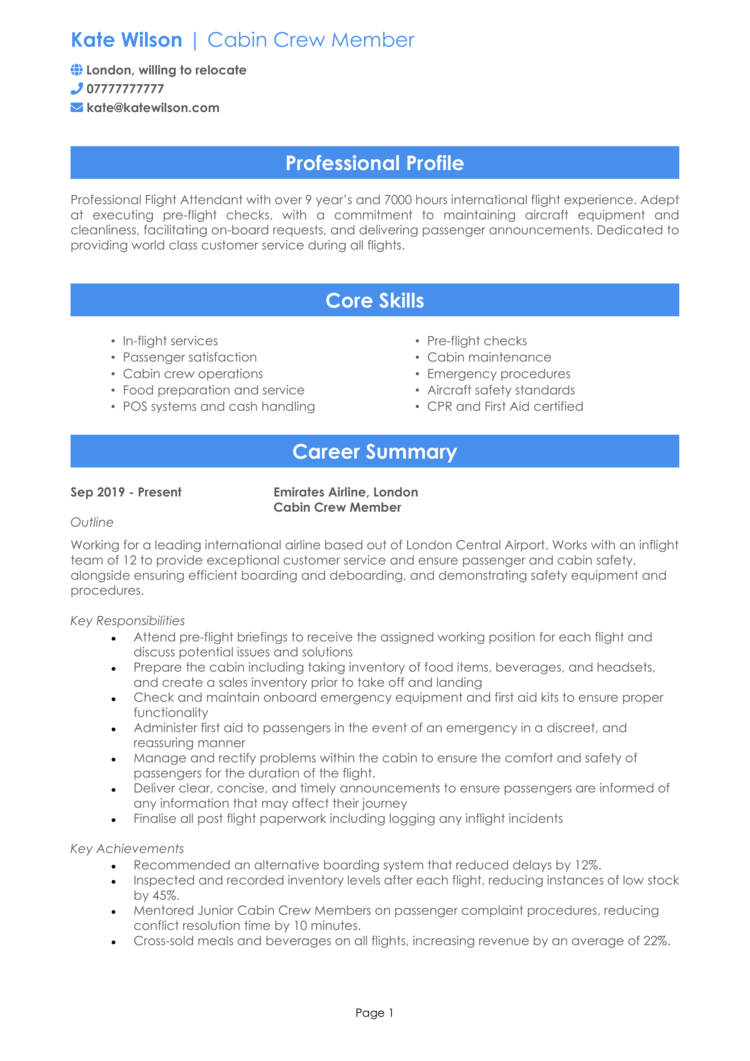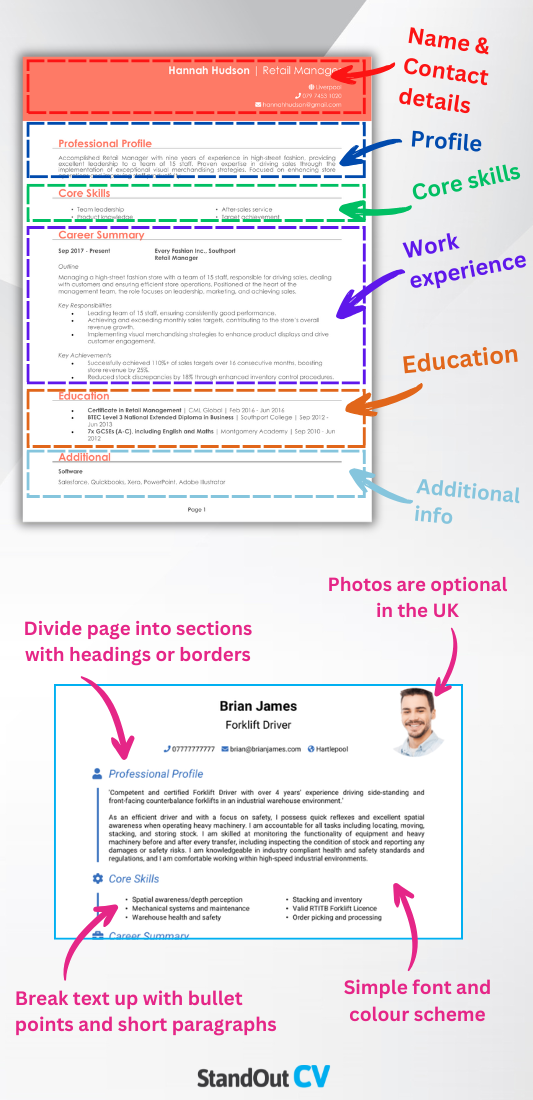Whether you’re piloting aircraft, ensuring passenger safety, or maintaining complex aviation systems, your expertise keeps the skies safe and operations running smoothly.
This guide and its Aviation CV examples will walk you through crafting an application that proves your technical knowledge, safety awareness, and the all-important ability to perform under pressure, giving you the best chance of landing your next role in the aviation industry.
Pilot CV example

Cabin Crew CV example

How to write your Aviation CV
Discover how to craft a winning Aviation CV that lands interviews with this simple step-by-step guide.
In aviation, precision and structure aren’t just important – they’re non-negotiable. Your CV should reflect the same attention to detail that you bring to your work, ensuring recruiters can instantly spot your most relevant qualifications and experience.
This guide will help you navigate the CV writing process, ensuring your application highlights your industry expertise and ability to work in a highly regulated, safety-first environment. Whether you’re in flight operations, aircraft maintenance, or ground services, this guide will help you structure a CV that’s ready for takeoff.
How to structure and format your Aviation CV


Aviation is a field where precision, efficiency, and structure matter – and your CV should reflect that. A well-organised and presentable CV ensures recruiters can quickly find your qualifications, experience, and technical expertise without unnecessary distractions.
Here’s the layout to follow:
- Name and contact details – Keep these personal details at the top so a potential employer can reach out to you: a photo is entirely optional.
- Profile – Kick things off with a concise overview of what makes you the ideal candidate for the job.
- Core skills – Briefly highlight those qualities which make you the best candidate, such as flight operations, safety compliance, or aircraft maintenance.
- Work experience – List your previous roles in reverse chronological order, with your most recent first.
- Education & certifications – Go through the academic history which underpins your expertise, like your degrees and certifications.
- Additional info – Optionally, include professional memberships, relevant hobbies, and awards you’ve earned.
A cluttered CV format is like a poorly filed flight plan – confusing and frustrating – so ensure yours is ready for a smooth landing. Use bullet points for clarity, divide sections with clear headings, and stick to a professional, easy-to-read font. Make sure it’s no longer than 2 pages: enough length to cover the essentials without boring the reader.
How to write an Aviation CV profile


Your CV profile should serve as a high-level summary of your aviation expertise, immediately showing recruiters why you’re a great fit for the role. As you know, every second counts in aviation: and recruiters only spend a short few actually reading your CV, so make sure to hook them right away.
Aviation CV profile examples
Profile 1
Experienced Commercial Pilot with five years of flight experience operating domestic and international routes. Skilled in aircraft navigation, flight safety procedures, and emergency response protocols. Proficient in using flight management systems and ensuring strict adherence to aviation regulations. Committed to delivering safe and efficient air travel for passengers and crew.
Profile 2
Detail-oriented Aircraft Maintenance Engineer with four years of expertise in diagnosing, repairing, and maintaining commercial and private aircraft. Skilled in troubleshooting mechanical and electrical systems, conducting pre-flight inspections, and ensuring regulatory compliance. Proficient in using maintenance software and technical manuals to perform high-precision repairs.
Profile 3
Skilled Air Traffic Controller with six years of experience managing aircraft movements, coordinating takeoffs and landings, and ensuring airspace safety. Adept at working in high-pressure environments, using radar systems, and issuing clear flight instructions to pilots. Dedicated to maintaining aviation safety and operational efficiency.
Details to put in your Aviation CV profile
Here’s some tips on what to include:
- Your aviation background – Mention whether you work in flight operations, engineering, air traffic control, or another aviation field.
- Key qualifications – Highlight any licences, endorsements, or certifications relevant to your role.
- Safety and compliance knowledge – Showcase your understanding of aviation regulations and operational protocols.
- Technical and operational expertise – Mention specific aircraft types, systems, or procedures you’re experienced with.
- Career objective – State your professional aspirations and how you can contribute to the company.
What to include in the core skills section of your CV


This section is your cockpit dashboard – everything recruiters need to know at a glance. Highlight the skills that matter most, from regulatory compliance to crisis management.
Tailor this list to the job you’re applying for – whether that’s piloting, maintenance, airport management, or aviation safety. Industry-specific skills like flight planning, avionics troubleshooting, and ground handling procedures can make your CV more targeted and impactful.
Recruiters often scan this section first, so make sure your key strengths are immediately visible.
What are the most important skills for an Aviation CV?
- Flight Operations Management – Overseeing flight schedules, air traffic coordination, and operational procedures.
- Aircraft Maintenance and Safety Compliance – Ensuring aircraft meet regulatory safety standards and undergo routine inspections.
- Navigation and Flight Planning – Calculating flight routes, fuel requirements, and weather conditions for safe travel.
- Air Traffic Communication – Coordinating with air traffic control to ensure smooth takeoffs, landings, and in-flight adjustments.
- Emergency Response and Crisis Management – Handling in-flight emergencies, safety protocols, and passenger assistance.
- Aviation Regulations and Compliance – Adhering to national and international aviation laws, including FAA, EASA, and ICAO regulations.
- Customer Service and Passenger Relations – Providing a high-quality travel experience while ensuring passenger safety and comfort.
- Aerodynamics and Aircraft Systems – Understanding the principles of flight, engine operations, and aircraft technology.
- Weather Analysis and Adaptation – Interpreting meteorological data to adjust flight paths and ensure safety.
- Ground Support and Logistics – Coordinating baggage handling, fueling, and aircraft turnaround times for efficient operations.
How to showcase your work experience in your CV


Your work experience should demonstrate not only what you’ve done, but how your contributions have improved safety, efficiency, or performance within an aviation setting.
If you’ve worked in different aviation sectors, highlight transferable skills such as teamwork, regulatory compliance, and emergency response procedures.
If you’re a recent graduate or transitioning from another industry, include internships, aviation coursework, or relevant experience that demonstrates your knowledge of the field.
How to format previous jobs in your CV correctly

- Outline – Provide a brief introduction to the airline, aviation company, or organisation you worked for.
- Responsibilities – Detail your key tasks, such as flight operations, maintenance, air traffic control, or ground support. Use action words like “managed,” “operated,” and “maintained.”
- Achievements – Highlight measurable successes, such as reducing aircraft downtime, improving safety measures, or optimising operational procedures.
Example work history for Aviation
Commercial Pilot | Skyward Airways
Outline
Operating domestic and international flights for a leading UK airline, ensuring passenger safety, efficient flight planning, and regulatory compliance.
Responsibilities
- Conducted pre-flight and post-flight checks to ensure aircraft safety and readiness.
- Worked closely with air traffic control to coordinate takeoff, landing, and in-flight route adjustments.
- Monitored weather conditions and adjusted flight paths as necessary for safety and efficiency.
- Provided clear communication with cabin crew and passengers to ensure smooth flight operations.
- Maintained compliance with aviation regulations and company safety policies.
Achievements
- Achieved a 98 percent on-time departure rate by optimising flight planning and coordination.
- Trained junior pilots, enhancing crew performance and safety awareness.
- Recognised for handling emergency situations with professionalism and composure.
Aircraft Maintenance Engineer | AeroTech Engineering Services
Outline
Providing technical maintenance and repair services for commercial aircraft, ensuring optimal performance and compliance with aviation safety standards.
Responsibilities
- Conducted routine inspections and preventive maintenance on aircraft components.
- Diagnosed and repaired mechanical, hydraulic, and electrical systems.
- Collaborated with flight crews to address technical concerns and ensure aircraft readiness.
- Maintained accurate records of maintenance work and compliance reports.
- Worked under strict safety regulations, following industry standards for aircraft maintenance.
Achievements
- Reduced aircraft downtime by 25 percent through efficient troubleshooting and repairs.
- Developed a new maintenance tracking system, improving workflow efficiency.
- Received industry recognition for outstanding contributions to aircraft safety.
Air Traffic Controller | Global Flight Operations
Outline
Managing air traffic operations for a busy international airport, ensuring safe and efficient aircraft movements within controlled airspace.
Responsibilities
- Monitored and directed aircraft movements using radar and communication systems.
- Issued takeoff, landing, and routing instructions to pilots in real time.
- Coordinated with ground control teams to manage airport congestion and prevent delays.
- Ensured strict adherence to aviation safety protocols and emergency procedures.
- Provided weather updates and flight path adjustments to enhance operational safety.
Achievements
- Maintained a 99.9 percent air traffic safety record through precise control and coordination.
- Implemented a new airspace management strategy, reducing congestion by 30 percent.
- Recognised for exceptional crisis management during emergency landing situations.
Structuring your education section


In aviation, certifications and licences often carry more weight than formal education, so list all education clearly and prominently.
Include your degrees, pilot licences, engineering certifications, or air traffic control qualifications. If you’ve completed additional safety, compliance, or technical training, make sure it’s featured in this section.
For those still working towards certain certifications, mention expected completion dates to show your commitment to professional development.
Top qualifications to showcase on an Aviation CV
- Pilot Licences (PPL, CPL, ATPL) – Essential for those in flight operations.
- Aircraft Maintenance Certifications (EASA Part 66, FAA A&P Licence) – Required for aviation engineers and mechanics.
- Air Traffic Controller Licence – Needed for ATC professionals.
- Aviation Safety & Compliance Training (ICAO, IATA, FAA regulations) – Demonstrates knowledge of industry standards.
- Airport Operations or Management Certification – Beneficial for ground crew and aviation administrators.





